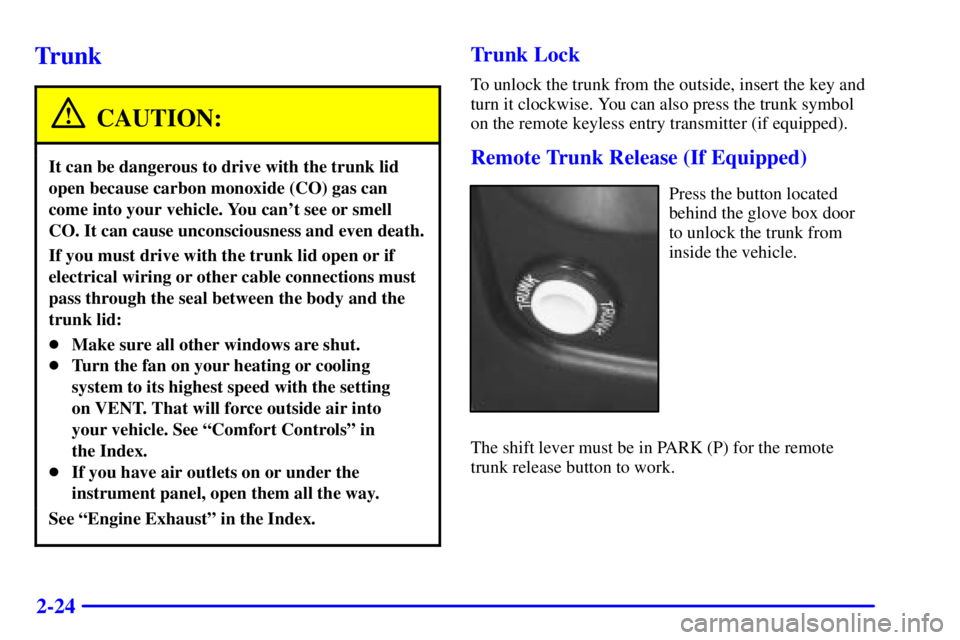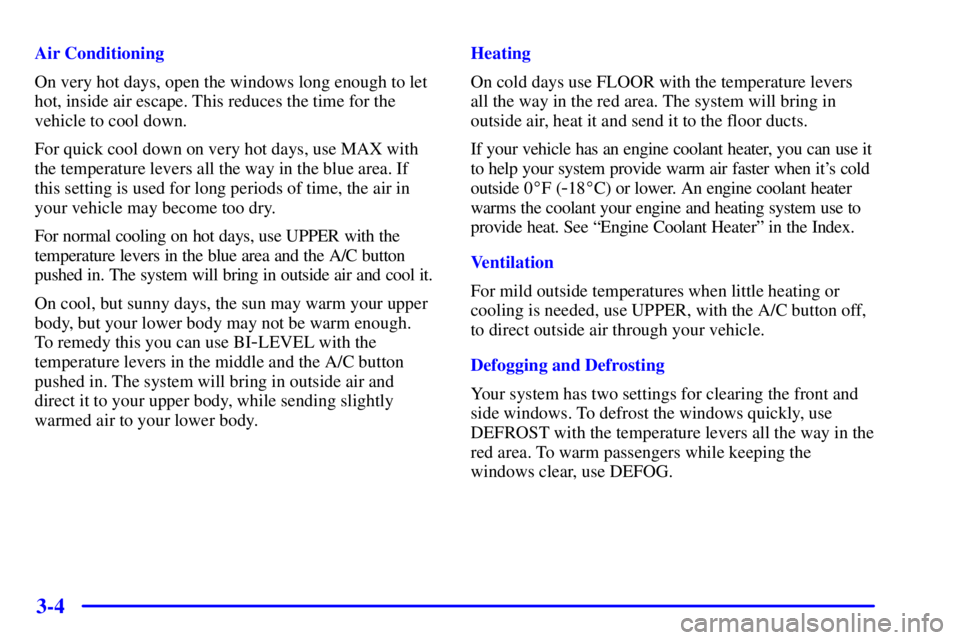Page 12 of 373
For
a More
Detailed Look at
What's Under the Hood
See Section 6
Tire Pressure
See Section 6
Service Station Guide
Oil Viscosity
Engine Oil
See Section 6
Engine Oil Dipstick
See Section 6Fuel
Use unleaded gas only.
See Section 6
for octane ratings.
Cooling System
See Section 5
Hood Release
See Section 6
Windshield Washer
Fluid
See Section 6
Spare Tire Pressure
See Section 5
Battery
See Section 6
Page 93 of 373

2-24
Trunk
CAUTION:
It can be dangerous to drive with the trunk lid
open because carbon monoxide (CO) gas can
come into your vehicle. You can't see or smell
CO. It can cause unconsciousness and even death.
If you must drive with the trunk lid open or if
electrical wiring or other cable connections must
pass through the seal between the body and the
trunk lid:
�Make sure all other windows are shut.
�Turn the fan on your heating or cooling
system to its highest speed with the setting
on VENT. That will force outside air into
your vehicle. See ªComfort Controlsº in
the Index.
�If you have air outlets on or under the
instrument panel, open them all the way.
See ªEngine Exhaustº in the Index.
Trunk Lock
To unlock the trunk from the outside, insert the key and
turn it clockwise. You can also press the trunk symbol
on the remote keyless entry transmitter (if equipped).
Remote Trunk Release (If Equipped)
Press the button located
behind the glove box door
to unlock the trunk from
inside the vehicle.
The shift lever must be in PARK (P) for the remote
trunk release button to work.
Page 148 of 373

2-79
�If the traction control system is affected by an
engine
-related problem, the system will turn off and
the warning light will come on.
When this warning light is on, the system will not limit
wheel spin. Adjust your driving accordingly.
Low Traction Light
If you have the
Enhanced Traction
System or the Traction
Control System, this
light will also come on
when the system is
limiting wheel spin.
You may feel or hear the system working, but this is
normal. Slippery road conditions may exist if the low
traction light comes on, so adjust your driving
accordingly. The light will stay on for a few seconds
after the Enhanced Traction System or the Traction
Control System stops limiting wheel spin. See
ªEnhanced Traction Systemº or ªTraction Control
Systemº in the Index.The low traction light also comes on briefly when you
turn the ignition key to RUN. If the light doesn't come
on then, have it fixed so it will be there to tell you when
the Traction Control System or Enhanced Traction
System is active.
Engine Coolant Temperature Light
This light tells you that
the engine coolant has
overheated or the radiator
cooling fan is not working.
If you have been operating the vehicle under normal
driving conditions, you should pull off the road, stop the
vehicle and turn off the engine as soon as possible.
See ªEngine Overheatingº in the Index.
Page 168 of 373

3-4
Air Conditioning
On very hot days, open the windows long enough to let
hot, inside air escape. This reduces the time for the
vehicle to cool down.
For quick cool down on very hot days, use MAX with
the temperature levers all the way in the blue area. If
this setting is used for long periods of time, the air in
your vehicle may become too dry.
For normal cooling on hot days, use UPPER with the
temperature levers in the blue area and the A/C button
pushed in. The system will bring in outside air and cool it.
On cool, but sunny days, the sun may warm your upper
body, but your lower body may not be warm enough.
To remedy this you can use BI
-LEVEL with the
temperature levers in the middle and the A/C button
pushed in. The system will bring in outside air and
direct it to your upper body, while sending slightly
warmed air to your lower body.Heating
On cold days use FLOOR with the temperature levers
all the way in the red area. The system will bring in
outside air, heat it and send it to the floor ducts.
If your vehicle has an engine coolant heater, you can use it
to help your system provide warm air faster when it's cold
outside 0�F (
-18�C) or lower. An engine coolant heater
warms the coolant your engine and heating system use to
provide heat. See ªEngine Coolant Heaterº in the Index.
Ventilation
For mild outside temperatures when little heating or
cooling is needed, use UPPER, with the A/C button off,
to direct outside air through your vehicle.
Defogging and Defrosting
Your system has two settings for clearing the front and
side windows. To defrost the windows quickly, use
DEFROST with the temperature levers all the way in the
red area. To warm passengers while keeping the
windows clear, use DEFOG.
Page 211 of 373
4-25
Hill and Mountain Roads
Driving on steep hills or mountains is different from
driving in flat or rolling terrain.If you drive regularly in steep country, or if you're
planning to visit there, here are some tips that can make
your trips safer and more enjoyable.
�Keep your vehicle in good shape. Check all fluid
levels and also the brakes, tires, cooling system
and transaxle. These parts can work hard on
mountain roads.
�Know how to go down hills. The most important
thing to know is this: let your engine do some of the
slowing down. Shift to a lower gear when you go
down a steep or long hill.
CAUTION:
If you don't shift down, your brakes could
get so hot that they wouldn't work well. You
would then have poor braking or even none going
down a hill. You could crash. Shift down to let
your engine assist your brakes on a steep
downhill slope.
Page 226 of 373

4-40 When You Are Ready to Leave After
Parking on a Hill
1. Apply your regular brakes and hold the pedal down
while you:
�Start your engine;
�Shift into a gear; and
�Release the parking brake.
2. Let up on the brake pedal.
3. Drive slowly until the trailer is clear of the chocks.
4. Stop and have someone pick up and store the chocks.
Maintenance When Trailer Towing
Your vehicle will need service more often when you're
pulling a trailer. See the Maintenance Schedule for more
on this. Things that are especially important in trailer
operation are automatic transaxle fluid (don't overfill),
engine oil, drive belts, cooling system and brake system.
Each of these is covered in this manual, and the Index will
help you find them quickly. If you're trailering, it's a good
idea to review this information before you start your trip.
Check periodically to see that all hitch nuts and bolts
are tight.
Engine Cooling When Trailer Towing
Your cooling system may temporarily overheat during
severe operating conditions. See ªEngine Overheatingº
in the Index.
Page 227 of 373
5-
5-1
Section 5 Problems on the Road
Here you'll find what to do about some problems that can occur on the road.
5
-2 Hazard Warning Flashers
5
-2 Other Warning Devices
5
-3 Jump Starting
5
-9 Towing Your Vehicle
5
-10 Engine Overheating5
-13 Cooling System
5
-23 If A Tire Goes Flat
5
-24 Changing a Flat Tire
5
-35 Compact Spare Tire
5
-36 If You're Stuck: in Sand, Mud, Ice or Snow
Page 239 of 373
5-13
Cooling System
When you decide it's safe to lift the hood, here's what
you'll see:
3100 V6 Engine
A. Electric Engine Cooling Fans
B. Radiator Pressure Cap
C. Coolant Recovery Tank
3800 V6 and 3800 V6 Supercharged Engines
A. Electric Engine Cooling Fans
B. Radiator Pressure Cap
C. Coolant Recovery Tank